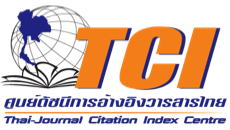ความชุกและปัจจัยเสี่ยงของการเกิดภาวะฮอร์โมนไทรอยด์ตํ่า ภายหลังการผ่าตัดต่อมไทรอยด์ออกหนึ่งข้าง
DOI:
https://doi.org/10.1016/hscr.v36i2.252427Keywords:
hypothyroidism, hemithyroidectomyAbstract
Objectives: To determine the prevalence and possible risk factors of postoperative hypothyroidism after hemithyroidectomy.
Methods: Medical records of patients who underwent hemithyroidectomy from January 2013 to December 2020 at Somdejphrajaotaksinmaharaj Hospital were retrospectively reviewed. Patients with preoperative euthyroid status were included. The postoperative thyroid function tests were obtained and prevalence of postoperative hypothyroidism was assessed afterwards. The potential risk factors associated with postoperative hypothyroidism were analyzed using Chi-square test or Fischer's exact test for categorical variables, and independent student t-test or Mann-Whitney U test for continuous variables.
Results: A total of 72 patients were included, of which 63 (87.5%) were female and 9 (12.5%) were male, with mean age of 47.69 ± 11.00 years. Postoperative hypothyroidism occurred in 22 patients (30.6%) at 6-8 weeks after surgery, including 8 (11.1%) with overt hypothyroidism and 14 (19.4%) with subclinical hypothyroidism. The mean preoperative serum thyroid stimulating hormone (TSH) level was significantly higher in the hypothyroid group than in the euthyroid group (p=0.026). Moreover, patients with preoperative serum TSH level higher than 1.5 mIU/L posed 4-fold higher risk for the development of hypothyroidism following hemithyroidectomy (OR 4.00; 95%CI=1.35-11.85, p=0.010).
Conclusions: Hypothyroidism was relatively common complication of hemithyroidectomy. The prevalence of postoperative hypothyroidism in this study was 30.4%. Also, preoperative serum TSH level that greater than 1.5 mIU/L was identified as risk factor associated with postoperative hypothyroidism after hemithyroidectomy. These finding suggests the need for proper preoperative counseling and effective postoperative follow-up protocol for the patients who are scheduled for hemithyroidectomy, particularly in whom with the risk factor of postoperative hypothyroidism.
References
2. Verloop H, Louwerens M, Schoones JW, Kievit J, Smit JW, Dekkers OM. Risk of hypothyroidism following hemithyroidectomy: systematic review and meta-analysis of prognostic studies. J Clin Endocrinol Metab 2012; 97: 2243-55.
3. Ullmann TM, Gray KD, Stefanova D, Limberg J, Buicko JL, Finnerty B, et al. The 2015 American Thyroid Association guidelines are associated with an increasing rate of hemithyroidectomy for thyroid cancer. Surgery 2019; 166: 349-55.
4. Kent WD, Hall SF, Isotalo PA, Houlden RL, George RL, Groome PA. Increased incidence of differentiated thyroid carcinoma and detection of subclinical disease. CMAJ 2007; 177: 1357-61.
5. Hall SF, Walker H, Siemens R, Schneeberg A. Increasing detection and increasing incidence in thyroid cancer. World journal of surgery 2009; 33: 2567-71.
6. Davies L, Welch HG. Increasing Incidence of Thyroid Cancer in the United States, 1973-2002. JAMA. 2006; 295: 2164-67.
7. Matsuzu K, Sugino K, Masudo K, Nagahama M, Kitagawa W, Shibuya H, et al. Thyroid lobectomy for papillary thyroid cancer: long-term follow-up study of 1,088 cases. World journal of surgery 2014; 38: 68-79.
8. Nixon IJ, Ganly I, Patel SG, Palmer FL, Whitcher MM, Tuttle RM, et al. Thyroid lobectomy for treatment of well differentiated intrathyroid malignancy. Surgery 2012; 151: 571-9.
9. Osmolski A, Frenkiel Z, Osmolski R. Complications in surgical treatment of thyroid diseases. The Polish otolaryngology 2006; 60: 165-70.
10. Farrar WB, Cooperman M, James AG. Surgical management of papillary and follicular carcinoma of the thyroid. Annals of surgery 1980; 192: 701-4.
11. Park S, Jeon MJ, Song E, Oh HS, Kim M, Kwon H, et al. Clinical features of early and late postoperative hypothyroidism after lobectomy. J Clin Endocrinol Metab 2017; 102: 1317-24.
12. Stoll SJ, Pitt SC, Liu J, Schaefer S, Sippel RS, Chen H. Thyroid hormone replacement after thyroid lobectomy. Surgery 2009; 146: 554-560.
13. Su SY, Grodski S, Serpell JW. Hypothyroidism following hemithyroidectomy: a retrospective review. Annals of surgery 2009; 250: 991-4.
14. Said M, Chiu V, Haigh PI. Hypothyroidism after hemithyroidectomy. World Journal of Surgery 2013; 37: 2839-44.
15. Piper HG, Bugis SP, Wilkins GE, Walker BA, Wiseman S, Baliski CR. Detecting and defining hypothyroidism after hemithyroidectomy. The American journal of surgery 2005; 189: 587-91.
16. Miller FR, Paulson D, Prihoda TJ, Otto RA. Risk factors for the development of hypothyroidism after hemithyroidectomy. Arch Otolaryngol Head Neck Surg 2006; 132: 36-8.
17. Koh YW, Lee SW, Choi EC, Lee JD, Mok JO, Kim HK, et al. Prediction of hypothyroidism after hemithyroidectomy: a biochemical and pathological analysis. Eur Arch Otorhinolargyngol 2008; 265: 453-7.
18. Chotigavanich C, Sureepong P, Ongard S, Eiamkulvorapong A, Boonyaarunnate T, Chongkolwatana C, et al. Hypothyroidism after hemithyroidectomy: the incidence and risk factors. J Med Assoc Thai 2016; 99: 77-83.
19. Garber JR, Cobin RH, Gharib H, Hennessey JV, Klein I, Mechanick JI, et al. Clinical practice guidelines for hypothyroidism in adults: cosponsored by the American Association of Clinical Endocrinologists and the American Thyroid Association. Thyroid 2012; 22: 1200-35.
20. Ahn D, Sohn JH, Jeon JH. Hypothyroidism following hemithyroidectomy: incidence, risk factors, and clinical characteristics. J Clin Endocrinol Metab 2016; 101: 1429-36.
21. McHenry CR, Slusarczyk SJ. Hypothyroidisim following hemithyroidectomy: incidence, risk factors, and management. Surgery 2000; 128: 994-8.
22. Pearce SH, Brabant G, Duntas LH, Monzani F, Peeters RP, Razvi S, et al. 2013 ETA guideline: management of subclinical hypothyroidism. European thyroid journal 2013; 2: 215-28.
Downloads
Published
How to Cite
Issue
Section
License
The names and email addresses entered in this journal site will be used exclusively for the stated purposes of this journal and will not be made available for any other purpose or to any other party.















